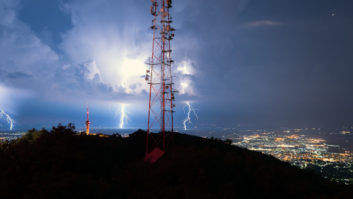I was the only radio industry journalist in the room recently when Harris Broadcast Communications Division President Tim Thorsteinson let slip to a group of reporters in New York that the big company will soon rename its broadcast division, which generates some $625 million a year in sales.
Harris Broadcast, he said, is soon to be called something else as the company seeks to position itself beyond its traditional niche. He made the comment during a discussion about the health of the business and its product plans for the NAB show.
Developments at Harris are something of a microcosm of our industry right now. I wonder if radio owners and managers will take away the right lessons.
Following growth
Thorsteinson is viewed as a turnaround specialist, and rarely does a company bring in one of those without soon cutting jobs, what Thorsteinson described as “taking some head count out.” That happened in February, when the division eliminated about 150 positions from its transmitter operations in Quincy, Ill., and Mason, Ohio, including 89 actual layoffs (story, page 8). Thorsteinson blamed a precipitous drop in TV transmitter sales for leaving the company with too much manufacturing capacity.
He told me late last year that the company remains committed to traditional radio and TV, and reiterated this point when announcing the staff cuts in February. Transmission remains an important component of the profitability of his division, he said, and Harris has done “very well” in HD Radio. It believes it has over half of that transmitter market and thinks HD Radio is going to be a growth sector abroad, as well.
However, the division president does plan a strategy of shifting investment from “mature” — flat or declining — markets to high-growth areas.
In a letter to staff, he said its radio and TV transmission businesses are being combined into a more focused, agile organization. Harris also will continue shopping for firms to acquire (its purchases since 2000 include Louth, Encoda, Invenio, Arkemedia, Leitch, Videotek, Inscriber, Aastra and OSI). It will focus more on traffic and billing; infrastructure; compression and networking solutions; and digital media workflows.
Harris wants more government work, both U.S. and abroad, and has added a Government Solutions Unit, based in Mason, to operate within the Broadcast Communications Division. So expect it to pursue more efforts like a recent multimillion-dollar contract to upgrade and expand the infrastructure of Romania’s state-owned broadcast organization. Last, it will aim to help its customers evolve to new media markets.
Weakness in Harris TV sales, Thorsteinson said, mostly has been made up in other areas. “On balance, things are fine.” He said the company is “trying to grow larger without losing the focus of some of our competitors who are really focused on the markets they’re in.”
He could have been talking about radio.
Job cuts are painful, affecting real people with real families. Some of the people who were let go had roots in the Allied days, I hear. And while it’s encouraging that the radio piece of the business at Harris is healthy relative to TV, one can’t note this sort of news without worrying about the direction of broadcast, not just for Harris but within any organization where you might be reading this article.
Defining ourselves
Harris, as well as suppliers that don’t have to report management details to the public, appear to be evolving their businesses, asking, “What is it exactly that we do? If ‘what we do’ is serving a mature market, how should we redefine it in order to grow?” A lesson resides here for radio and those of us who make our living from it.
As we watch media evolve around us, station owners, engineers and trade journalists should be asking ourselves: Are we adapting? Are we taking a cue from our consumers’ trends and business, shifting our personal and professional goals, challenging ourselves to rethink the definitions of the businesses we are in?
Or, like many in radio over decades, do we fight defiantly to protect our traditional self-definitions? Do we limit ourselves rigidly to certain kinds of hardware, spectrum, modes of programming, engineering and selling, ways of thinking?
I wrote here near the beginning of the first Web boom that radio might profit from new media trends but could also be overwhelmed by them, that we could convert radio’s strong brands into powerful online channels or we could let those channels steal from us.
Today we see headlines in the New York Times about how online video might be the savior of the radio industry (a simplistic overstatement, which is not an unusual occurrence in print reporting about radio, but indicative of valid trends). We hear Peter Smyth, one of the most influential people in radio through his leadership at Greater Media and RAB, noting that Internet radio is growing strongly, driven by local radio station streams that are attracting listeners at quadruple the rate of Internet-only stations.
We can sit around and bemoan the maturation and eventual decline of “radio as we know it.” Or we can appreciate the incredible market position radio enjoys, the century of loyalty and the big revenue base — which are significant advantages over startup media — and use our momentum to build new successful business models. But we must ask the questions. Smart managers like Smyth are talking about how radio needs to take product risks, address missing demographics and address our problems effectively. They’re also asking themselves, constantly, “What are we, and what must we be?”
At the Harris event, Brian Cabeceiras, vice president of strategic marketing & technology, told reporters that the “core broadcast market is still a very strong business. New media companies aren’t going to drive old ones away.” Legacy media, he said, “will be the leaders in the new world order.”
Radio is legacy media by anyone’s definition. I agree with Cabeceiras that we can be leaders, but it won’t happen without conscious planning up and down the radio decision ladder.
Thorsteinson wants to grow his broadcast business — or whatever the division will be called — 8 to 10 percent per year. I hope our $20 billion commercial radio industry can be citing those kinds of growth numbers soon, rather than the flat performance of recent years that so scares some investors away. If leaders like Smyth continue to push new and better thinking about what business they’re in, maybe we will.
There’s a big, lucrative future ahead for effective communicators of great content. Radio and its suppliers can benefit if we think of ourselves that way.
Comment on my column or any article to [email protected].












